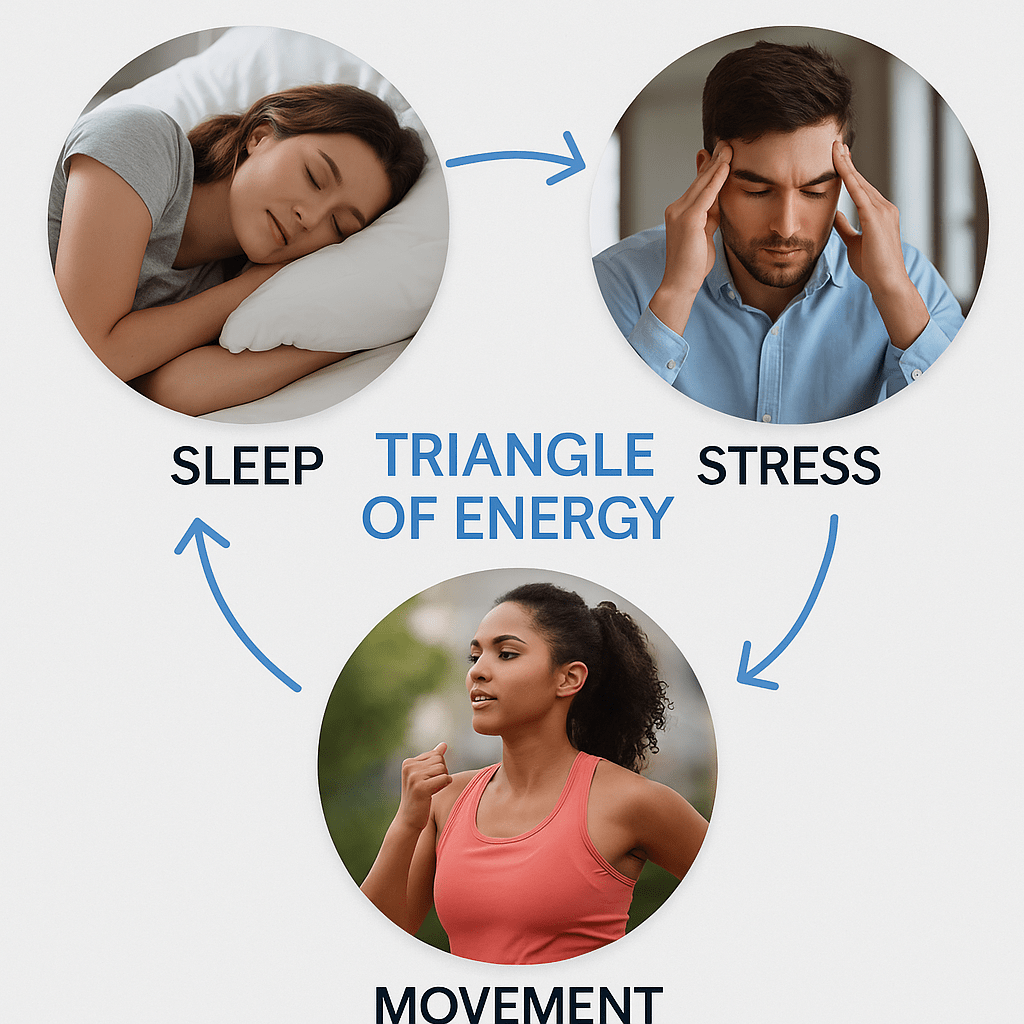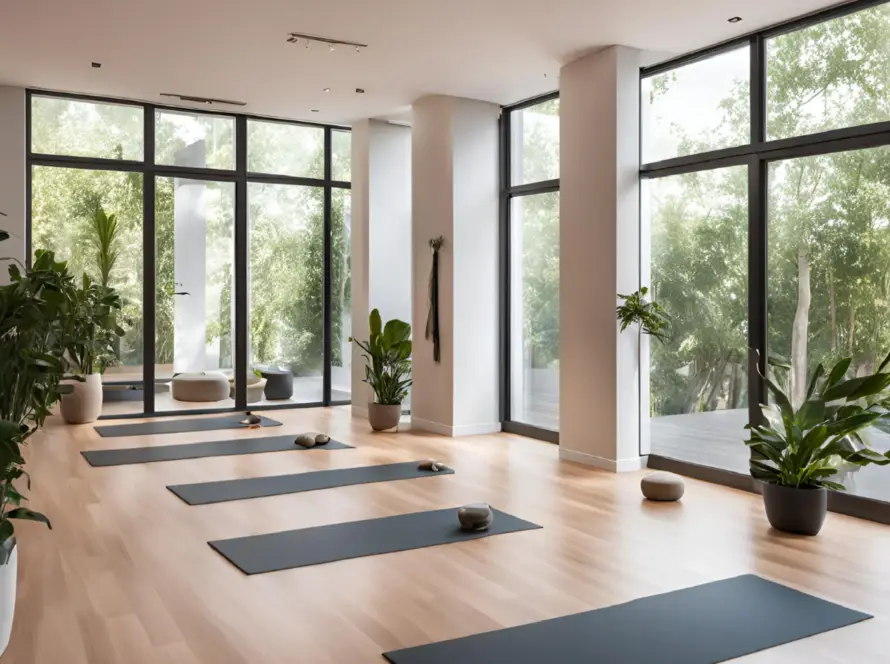Why energy isn’t random. It’s rhythmic
You wake up groggy. By 3 PM, you’re drained. You push through the rest of the day, only to collapse into bed wired and restless. Sound familiar?
This isn’t just “being busy.” It’s energy imbalance often caused by one or more of your core systems falling out of sync. We call this the Triangle of Energy: sleep, stress, and movement. Together, they form the foundation for how energized or exhausted you feel on any given day.
Your energy isn’t about willpower. It’s about alignment.
The first side of the triangle — Sleep
Sleep is your primary recovery system. Without deep, consistent rest, your body stays in partial shutdown affecting hormones, mood, focus, and immunity.
How poor sleep depletes energy
- Inconsistent sleep schedules confuse your body clock
- Light, restless sleep prevents full cellular repair
- Sleep debt builds silently, lowering motivation and immune resilience
Lack of quality sleep affects everything from glucose regulation to emotional regulation. Sleep is not just a comfort you provide to your body. It’s a necessity.
Simple sleep rituals that help
You don’t need a perfect bedtime routine to get better rest. You just need consistency and intention.
- Unplug from screens at least 30–60 minutes before bed
- Use low lighting to trigger melatonin naturally
- Consider adding a sleep support supplement with magnesium, L-theanine, or ashwagandha
- Keep your bedtime and wake-up times consistent even on weekends
Sleep is your body’s original recharge system. When it’s stable, energy becomes much easier to manage.
The second side — Stress regulation
Stress isn’t always the culprit. In small doses, it sharpens our focus and motivation. But when stress lingers, it becomes one of the biggest energy leaks in the triangle.
What stress actually does to your body
- Elevates cortisol, making your body feel wired but exhausted
- Disrupts digestion, immune response, and cognitive clarity
- Drains emotional capacity, leading to irritability and burnout
Chronic stress doesn’t just make you feel tired. It actually slows everything down, especially your ability to recover.
How to reduce stress without quitting your life
You don’t need a vacation to lower your stress load. You need micro-resets throughout the day.
- Try 3 slow, intentional breaths at the top of each hour
- Schedule a 10-minute walk with no phone
- Sip a warm drink or herbal tea midafternoon
- Use adaptogenic support (like rhodiola or holy basil) to help regulate your stress hormones
These are not indulgences. They’re your nervous system’s version of recalibration.
The third side — Movement
When you’re tired or overwhelmed, movement is often the first thing to go. Ironically, it’s also one of the most effective ways to generate sustainable energy.
Why movement boosts energy (even when you feel tired)
Movement increases blood flow, improves oxygenation, and helps your body metabolize stress hormones. It doesn’t have to be intense but intentional.
Daily movement that doesn’t require a gym
- Stretch for 3–5 minutes after waking
- Walk during phone calls or while listening to a podcast
- Do 10 jumping jacks between emails
- Add evening mobility routines to release tension
Pairing movement with natural energy support (like B-complex vitamins or low-stimulant formulas) can help restore motivation when you feel sluggish.
The triangle in balance — how it works together
Each point of the triangle supports the others:
- When sleep improves, your ability to manage stress rises
- When stress lowers, your sleep becomes more restorative
- When you move more, you release built-up tension and sleep better
- When all three work together, energy feels natural, not forced
That’s the power of synergy.
Energy isn’t built in one place. It is distributed
If one corner of the triangle is weak, the whole structure wobbles. But here’s the good news: improving just one side helps stabilize the others.
It doesn’t require a perfect routine. Just consistent attention to where your body needs support.
A daily approach to balancing your energy triangle
Here’s a basic template you can customize based on your day:
|
Time |
Focus |
Action |
|
Morning |
Movement |
Light stretch or short walk before checking your phone |
|
Mid-morning |
Stress |
Breathe deeply while your coffee brews |
|
Midday |
Nutrition |
Eat slowly and step away from screens for 10 minutes |
|
Afternoon |
Movement |
Take a walk or stretch after lunch |
|
Evening |
Sleep Prep |
Lower lights, unplug, take a sleep support formula |
Start small. Choose one change in each category. Let them build on each other.
How supplements can support energy alignment
While lifestyle habits are the foundation, targeted wellness supplements can fill in the gaps especially when your schedule or environment makes it hard to stay consistent.
Smart, supportive choices
- Magnesium glycinate to support deep sleep
- Ashwagandha or holy basil for daily stress balance
- B-complex or adaptogen blends to help with focus and fatigue
- Electrolytes to stay hydrated and mentally sharp
Use supplements to support the habits you’re building and not as a replacement. That’s where they work best.
When energy feels hard, start here
Burnout isn’t always dramatic. Sometimes, it just feels like… going through the motions.
If your motivation is low, your body feels heavy, and nothing seems to stick, pause and check your triangle. Which corner needs the most love—sleep, stress, or movement?
Start there. One action a day is enough.
You don’t need to do more. You need better balance.
You don’t have to become someone new to feel more energized. You just need to bring your triangle back into alignment with small, repeatable actions.
- Sleep like it matters
- Manage stress before it manages you
- Move your body like it deserves support
And when you’re ready for clean, gentle energy support along the way, RegenHealth is here to guide you—step by step, one corner at a time.




